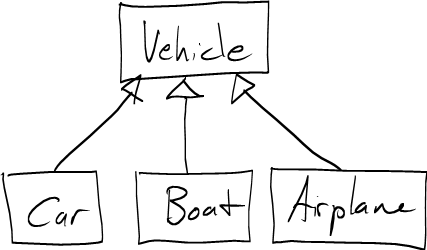Note: The course notes on objects, arrays, and references will be useful.
Inheritance
Inheritance is an IS-A relationship between two classes.
For example, consider the classes Vehicle, Car, Boat, and Airplane.
A Car is a Vehicle. A Boat is a Vehicle. An Airplane is a Vehicle.
We describe IS-A relationships using a class hierarchy diagram:
The Car,. Boat, and Airplane classes inherit from the Vehicle class.
Superclasses and subclasses
In this class hierarchy, Vehicle is the superclass of Car, Boat, and Airplane.
Equivalently, Car, Boat, and Airplane are subclasses of Vehicle.
Because classes are data types, we also describe an inheritance relationship as a supertype/subtype relationship.
When Inheritance is Useful
Inheritance is useful when you have a collection of classes which both common characteristics and behavioral differences.
The common characteristics of the classes are embodied in the superclass. The most important kind of commonality in classes related by inheritance is that they support a common set of operations (methods).
For example, let’s say that Car, Boat, and Airplane classes support the following operations:
- They can start a trip
- They can move over/through terrain
- They can end a trip
These common operations become the methods of the Vehicle class, which is the superclass of all three classes.
There are behavioral differences in the three classes because they implement the common operations differently:
- A car can start a trip, move, and end a trip only where there are roads. (Airports and marinas are considered to have roads.)
- A boat can start a trip, move, and end a trip only where there is water. (A marina is considered to have water.)
- An airplane can move over any kind of terrain, but must start and end its trip at airports.
So, for example, if we call the startTrip method on an Airplane object, it will only succeed if the Airplane is currently located at an airport.
Abstract Methods and Classes
Typically, the methods in the superclass that embody the common operations (methods) shared by subclasses will be abstract. This sense of abstract means that there is no way to concretely what the operation does unless we know what kind (subclass) of object it is called on.
Because they usually have abstract methods, superclasses are ususally abstract classes. An abstract class cannot be directly instantiated.
For example, if I told you I arrived at work in a Vehicle, that tells you nothing about whether I arrived by ground, air, or water. That’s because you don’t know what specific kind of Vehicle I arrived in.
The Liskov Substitution Principle, Polymorphism
A simple rule called the Liskov Substitution Principle explains how to use inheritance in a program. It states:
Anywhere in a program an instance of a superclass may be used, an instance of a subclass may be used.
So, if we have a method that takes a parameter whose type is Vehicle, we can pass that method a reference to a Car, Boat, or Airplane, since those are all subclasses of Vehicle.
The Liskov Substitution Principle allows object-oriented programs to exhibit polymorphism. Polymorphism means that a variable with type A might, when the program runs, actually refer to an object of type B, C, D, etc. This is possible as long as B, C, and D are all subclasses of A.
An Example
public enum Terrain {
ROAD,
AIRPORT,
WATER,
MARINA,
FIELD,
FOREST,
MOUNTAIN;
}
public abstract class Vehicle {
public abstract boolean startTrip(Terrain t);
public abstract boolean endTrip(Terrain t);
public abstract boolean move(Terrain t);
}
public class Car extends Vehicle {
public boolean endTrip(Terrain t) {
if ( t == Terrain.AIRPORT || t == Terrain.MARINA ) {
return true;
} else {
return false;
}
}
public boolean move(Terrain t) {
if ( t == Terrain.AIRPORT || t == Terrain.MARINA || t == Terrain.ROAD ) {
return true;
} else {
return false;
}
}
public boolean startTrip(Terrain t) {
if ( t == Terrain.AIRPORT || t == Terrain.MARINA ) {
return true;
} else {
return false;
}
}
}A Trip consists of a sequence of Terrain values:
public class Trip {
private Terrain[] hops;
public Trip(int numHops) {
if (numHops < 2) {
throw new IllegalArgumentException("Trips must have at least a start and finish");
}
this.hops = new Terrain[numHops];
}
public void setHop(int hop, Terrain t) {
hops[hop] = t;
}
public boolean isTripPossible(Vehicle v) {
// Check the first hop
if (!v.startTrip(hops[0])) {
return false;
}
// Check all hops between the first and last
for (int i = 1; i < hops.length - 1; i++) {
if (!v.move(hops[i])) {
return false;
}
}
// Check the last hop
if (!v.endTrip(hops[hops.length - 1])) {
return false;
}
// success!
return true;
}
}The isTripPossible method of the Trip class takes a Vehicle as a parameter, and returns true or false depending on whether or not the Vehicle can successfully complete the trip. We see polymorphism at work because an instance of any subclass of Vehicle may be passed to isTripPossible.
We can use the Trip class to write JUnit tests which test the Car class.
For example, a trip starting at an airport, continuing through roads, and ending at a marina is a legal trip. A trip blocked by a terrain type inaccessible to a Car, such as WATER, is not a legal trip.
public class CarTest extends TestCase {
private Trip legalTrip;
private Trip illegalTrip;
private Car myCar;
protected void setUp() throws Exception {
// a Trip that can be completed by Car
legalTrip = new Trip(4);
legalTrip.setHop(0, Terrain.AIRPORT);
legalTrip.setHop(1, Terrain.ROAD);
legalTrip.setHop(2, Terrain.ROAD);
legalTrip.setHop(3, Terrain.MARINA);
// a Trip that cannot be completed by Car
// because it contains a hop through WATER
illegalTrip = new Trip(5);
illegalTrip.setHop(0, Terrain.AIRPORT);
illegalTrip.setHop(1, Terrain.ROAD);
illegalTrip.setHop(2, Terrain.ROAD);
illegalTrip.setHop(3, Terrain.WATER); // Not possible by Car!
illegalTrip.setHop(4, Terrain.MARINA);
myCar = new Car();
}
public void testLegalTrip() throws Exception {
assertTrue(legalTrip.isTripPossible(myCar));
}
public void testIllegalTrip() throws Exception {
assertFalse(illegalTrip.isTripPossible(myCar));
}
}
